
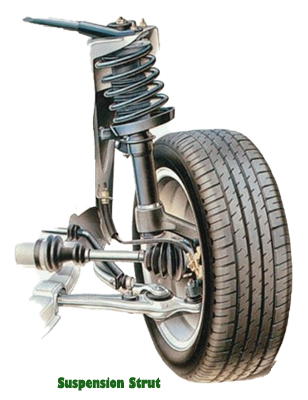 Strut type shock absorbers are an innovation of the second half of the Twentieth century, developed to be compatible with the single bodies (monocoque) designed vehicles that became the first choice for the mass production niche starting from the US rapidly spreading throughout the UK and Europe.
Strut type shock absorbers are an innovation of the second half of the Twentieth century, developed to be compatible with the single bodies (monocoque) designed vehicles that became the first choice for the mass production niche starting from the US rapidly spreading throughout the UK and Europe.
While doing the same job as conventional shock absorbers, struts enjoy the advantage of being considerably more robust.
Initially developed to suit small to medium-sized front-wheel drive vehicles, it is now possible to find struts that will do a fine job on larger single-shelled vehicles with constant tweaks over the years.
Struts make up a major structural constituent of a vehicle's suspension, replacing the upper ball joint and upper control arm as standard in conventional suspensions.
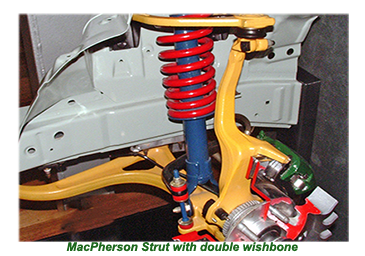 Despite being both lighter and less bulky than conventional shock absorbers, struts can perform dual functions. As well as absorbing shocks, struts also provide structural support for the vehicle suspension and springs while aligning the vehicle's tires.
Despite being both lighter and less bulky than conventional shock absorbers, struts can perform dual functions. As well as absorbing shocks, struts also provide structural support for the vehicle suspension and springs while aligning the vehicle's tires. From the outside, struts and shock absorbers are almost identical in appearance, despite their many advantages, They also operate in virtually the same fashion, with the sole difference being that the strut is fitted with a valve that controls resistance levels to match the velocity of the suspension.
The subtle difference between struts and absorbers is that struts are mounted to the vehicle's chassis on the top, making them a structural part of the suspension system.
The bottom of the strut body is attached to the steering knuckle, which connects to a lower control arm through a lower ball joint.
![]()
Struts also replace the upper control arm and connect directly to the knuckle on the car, providing a secondary ability to adjust alignment.
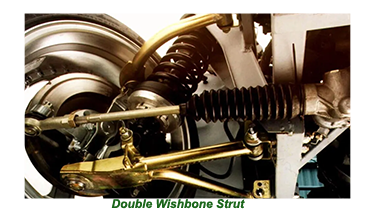 Found on vehicles that have not been fitted with an upper control arm, their presence of means that struts can only be connected to the suspension system via a knuckle.
Found on vehicles that have not been fitted with an upper control arm, their presence of means that struts can only be connected to the suspension system via a knuckle.
Vehicles fitted with independent suspension with either an upper and lower control arm or a solid rear axle are equipped with shock absorbers.
All vehicles will either be fitted with shock absorbers or struts on each of their four corners. There are even cases of vehicles fitted with struts on the front with shock absorbers on the back.
The most widely used version of the strut is the MacPherson, named after its designer Earle S. MacPherson who developed the design for Chrysler Motors in the immediate post-war years.
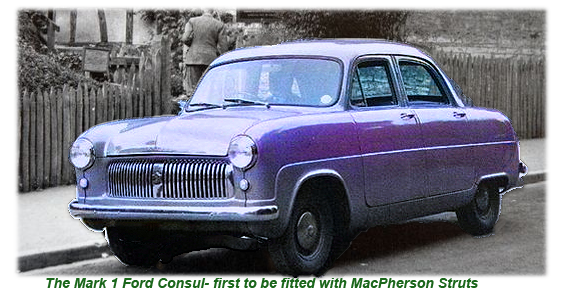 Widely fitted in most vehicles' front suspension since, the Macpherson strut utilises a telescopic damper as the upper steering pivot.
Widely fitted in most vehicles' front suspension since, the Macpherson strut utilises a telescopic damper as the upper steering pivot.
While Chrysler began to fit some of their compact models with Macpherson struts, reception was lukewarm, and the company started to lose interest.
Disenchanted, MacPherson took himself and his design concepts to Ford, who were more prepared to grasp the concept, providing their vast capital and research facilities to boost the strut's development.
From the outset, Ford treaded warily, preferring to test the concept in the UK before the US, fitting MacPherson struts in the 1950 Mark 1 Ford Consul.
From then onwards, the only way was up , with the Macpherson strut going on to become an icon.
![]()
Like all good things, the MacPherson strut has a limited life span- not as long as the conventional shock absorber, but nowhere near as expensive to replace.
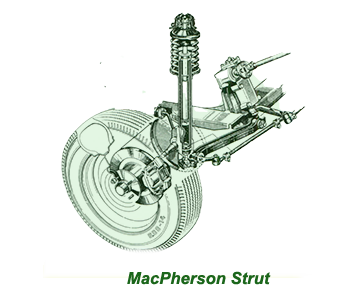 When considering a vehicle for restoration, it's pretty easy to spot that its struts are no longer in the best condition without even starting the engine.
When considering a vehicle for restoration, it's pretty easy to spot that its struts are no longer in the best condition without even starting the engine.
All that is required is to push down on each corner of the vehicle, and if it begins to bounce excessively, it's a sure sign that the struts, Macpherson or otherwise, are starting to fail and should be changed.
 Replacing MacPherson struts can be a major headache, but not impossible for a person with reasonable skills and the proper equipment.
Replacing MacPherson struts can be a major headache, but not impossible for a person with reasonable skills and the proper equipment.
 The first thing to remember is that all struts need to be replaced in pairs- either front of bock and never one front and back.
The first thing to remember is that all struts need to be replaced in pairs- either front of bock and never one front and back.
 Those who want to tackle the job in-house have to explicitly follow the manufacturer's instructions remembering to be extra careful when releasing the spring.
Those who want to tackle the job in-house have to explicitly follow the manufacturer's instructions remembering to be extra careful when releasing the spring.
Having a set of spring compressors on hand is a must and should be used during the un-assembling and re-assembling process.
With a lot of care and attention, changing the struts can be achieved without involving outside sources meaning that a fair chunk of the restoration budget can be saved.
